Postural Syndrome
Updated:
What is postural syndrome?
Postural syndrome of the lumbar spine is a condition that causes pain in the lower back without any significant trauma or damage to tissue. Patients with postural syndrome only experience symptoms, such as an ache or pain in the lower back, during activities that place sustained stress on normal tissue (most commonly, this is due to sustained poor posture).
The mechanism of pain onset in this condition can be demonstrated by gently bending your index finger backwards until you feel a stretch (figure 1). At this point there is no tissue damage or pain, however, if you maintain this position for long enough, your finger will gradually become painful or ache. Once the finger is released and allowed to change position, the pain or ache will ease. Postural syndrome in the lower back occurs in a similar fashion and typically occurs due to sitting or standing in poor positions for prolonged periods of time (figures 2 & 3).
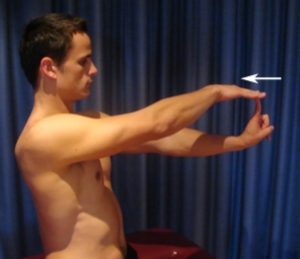
When sitting slouched (figure 2), your lower back goes into its maximal forward bend (similar to standing and touching your toes). This places considerable stretching force and increased load on the joints of your lower back and will gradually cause symptoms such as pain or an ache if maintained for excessive periods of time. Similarly, when standing in poor posture (figure 3) considerable stress is placed on the joints of your lower back. This too will gradually cause symptoms such as pain or an ache if sustained for too long.
When individuals experience lower back pain or an ache due to sustained poor postural positions in the absence of tissue damage, the condition is known as postural syndrome of the lumbar spine.
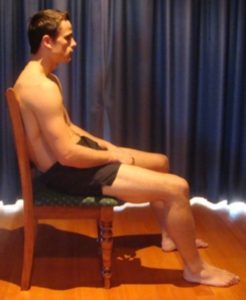
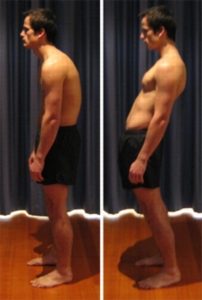
Causes of postural syndrome
Postural syndrome is a condition that is caused by adopting poor posture over a prolonged period of time. This may occur in any position such as standing or lying, but is particularly common during sitting (e.g. at a computer, when driving or watching television).
Postural syndrome is also relatively common during everyday activities that encourage prolonged forward bending of the lower back, such as gardening, vacuuming, sweeping, or washing dishes at an inappropriate sink height.
In sport, postural syndrome is often seen in athletes whose activity involves prolonged bending forward postures such as cycling, hockey players, baseball catchers and wicket keepers in cricket.
Signs and symptoms of postural syndrome
Patients with postural syndrome typically have normal, pain-free movement. Symptoms are only experienced when poor posture is maintained for prolonged periods. This can occur in various positions such as standing, sitting, deep squatting or lying.
Pain is typically experienced as a dull ache in the lower back region and can occasionally be accompanied by symptoms in the upper back, shoulders or neck. Usually the pain associated with this condition will quickly ease upon moving or changing positions, thereby taking the strain off the affected structures.
Diagnosis of postural syndrome
A thorough subjective and objective examination from a physiotherapist is usually sufficient to diagnose postural syndrome of the lower back. Investigations such as an X-ray, MRI or CT scan may be required, in rare cases, to rule out other conditions.
Treatment for postural syndrome

Members Only ContentBecome a PhysioAdvisor Member to gain full access to this exclusive content. For more details see Become a Member. Already a member? Login Now
Achieving good posture

Members Only ContentBecome a PhysioAdvisor Member to gain full access to this exclusive content. For more details see Become a Member. Already a member? Login Now
Prognosis of postural syndrome
The prognosis of patients with postural syndrome is excellent provided the patient is motivated and compliant with physiotherapy treatment, advice and exercises. Most patients can achieve pain free status immediately upon correction of poor posture. Retraining movement patterns and performing appropriate exercises is essential to prevent symptom recurrence.
Physiotherapy for postural syndrome

Members Only ContentBecome a PhysioAdvisor Member to gain full access to this exclusive content. For more details see Become a Member. Already a member? Login Now
Contributing factors to the development of postural syndrome
There are several factors that may contribute to the development of postural syndrome of the lower back. These factors need to be assessed and corrected with direction from a physiotherapist and may include:
- poor posture
- poor ergonomic set-up
- joint stiffness (particularly of the lower back or hips)
- a sedentary lifestyle
- poor core stability
- muscle weakness (particularly of the lower back, upper back extensors and scapula retractors)
- muscle tightness (particularly the gluteals, hip flexors, abdominals and hamstrings)
- a lifestyle or occupation involving large amounts of sitting, bending, slouching, shoulders forwards activities or lifting
- inappropriate chair or workstation set-up
- decreased fitness or fatigue
- a lifestyle involving excessive use of computers, laptops and television
- inadequate recovery periods from poor postural positions
Exercises for postural syndrome
The following exercises are commonly prescribed to patients with this condition. Some of the exercises improve postural alignment of the neck and upper back, which subsequently encourages optimal posture in the lower back. You should discuss the suitability of all these exercises with your physiotherapist prior to beginning them. Generally, the initial and intermediate exercises should be performed 3 – 5 times daily, whilst the advanced exercises should be performed twice daily.
All exercises should only be performed provided they do not cause or increase symptoms. Your physiotherapist can advise when it is appropriate to begin the initial exercises and eventually progress to the intermediate and advanced exercises. As a general rule, addition of exercises or progression to more advanced exercises should only take place provided there is no increase in symptoms.
Initial Exercises
Elbow Prop
Begin lying on your stomach (figure 8). Slowly move up onto your elbows provided it does not cause or increase your symptoms. Hold this position for 2 – 5 seconds and then return to lying flat. Repeat 10 times provided there is no increase in symptoms. Repeat 3 – 5 times daily.
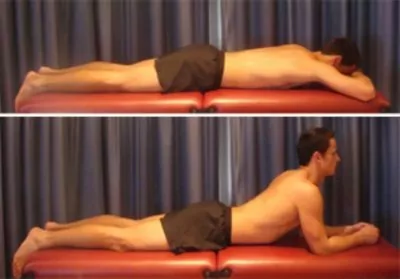
Shoulder Blade Squeezes
Begin sitting or standing tall with your back and neck straight (figure 9). Squeeze your shoulder blades together as far as you can go without pain and provided you feel no more than a mild to moderate stretch. Hold for 5 seconds and repeat 10 times provided the exercise is pain free. Repeat 3 – 5 times daily.

Chin Tucks
Begin sitting or standing tall with your back and neck straight, shoulders should be back slightly (figure 10). Tuck your chin in as far as you can go without pain and provided you feel no more than a mild to moderate stretch. Keep your eyes and nose facing forwards. Hold for 2 seconds and repeat 10 times provided the exercise is pain free. Repeat 3 – 5 times daily.
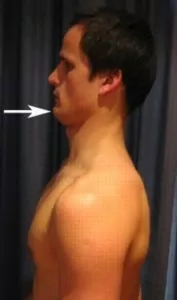
Intermediate Exercises

Members Only ContentBecome a PhysioAdvisor Member to gain full access to this exclusive content. For more details see Become a Member. Already a member? Login Now
Advanced Exercises

Members Only ContentBecome a PhysioAdvisor Member to gain full access to this exclusive content. For more details see Become a Member. Already a member? Login Now
Rehabilitation Protocol for postural syndrome

Members Only ContentBecome a PhysioAdvisor Member to gain full access to this exclusive content. For more details see Become a Member. Already a member? Login Now
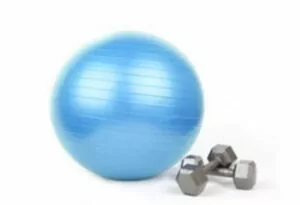 Physiotherapy products for postural syndrome
Physiotherapy products for postural syndrome
Some of the most commonly recommended products by physiotherapists to assist patients with this condition include:
-
 Wheat Bags
Wheat Bags -
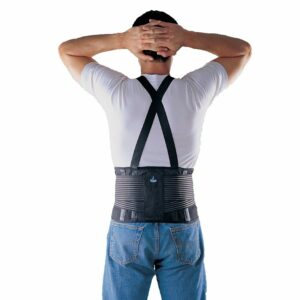 Oppo Industrial Back Support (OPP2169)
Oppo Industrial Back Support (OPP2169) -
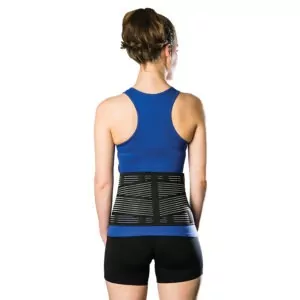 AllCare Ortho Light Back Support
AllCare Ortho Light Back Support -
 OPPO – Posture Aid / Clavicle Brace (OPP2075)
OPPO – Posture Aid / Clavicle Brace (OPP2075) -
 Premium Strapping Tape 38mm (Victor)
Premium Strapping Tape 38mm (Victor) -
 AllCare Pro-TENS Machine
AllCare Pro-TENS Machine -
 AllCare Spikey Massage Ball
AllCare Spikey Massage Ball -
 Fixomull Stretch 5cm x 10m
Fixomull Stretch 5cm x 10m -
 AllCare Foam Roller Round
AllCare Foam Roller Round -
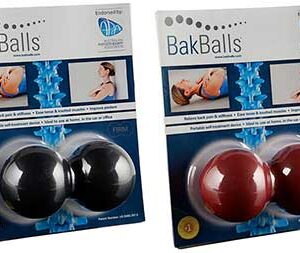 BakBalls
BakBalls -
 McKenzie Treat Your Own Back Book
McKenzie Treat Your Own Back Book -
 Lumbar Rolls (‘D’ Shaped)
Lumbar Rolls (‘D’ Shaped)
To purchase physiotherapy products for this condition click on one of the above links or visit the PhysioAdvisor Shop.
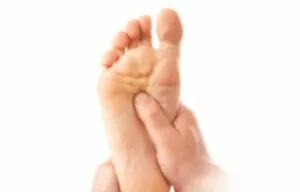 Find a Physio for postural syndrome
Find a Physio for postural syndrome
Find a physiotherapist in your local area who can treat this condition.
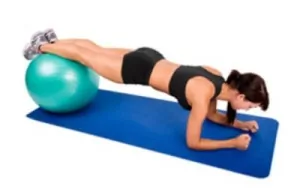
More Exercises
- Lower Back Stretches.
- Lower Back Strengthening Exercises.
- Postural Exercises.
- Basic Pilates Exercises.
- Cardiovascular Exercise.
- Core Stability Exercises.
- Gym Exercises
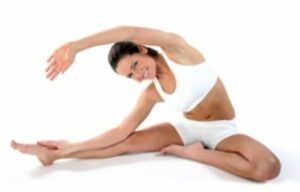 Recommended Reading
Recommended Reading
- Correct Posture
- Postural Taping
- Back Taping
- Mobile Phone Ergonomics
- Ergonomic Computer Setup
- Bike Setup
- Choosing a School Bag
- Safe Lifting
- Lower Back Pain Diagnosis Guide
Become a PhysioAdvisor Member

Link to this Page
If you would like to link to this article on your website, simply copy the code below and add it to your page:
<a href="https://physioadvisor.com.au/injuries/lower-back/postural-syndrome”>Postural Syndrome – PhysioAdvisor.com</a><br/>PhysioAdvisor offers detailed physiotherapy information on poor posture, postural pain and postural syndrome including signs and symptoms, causes, diagnosis, treatment, exercises, rehabilitation protocol and more...
Return to the top of Postural Syndrome.

